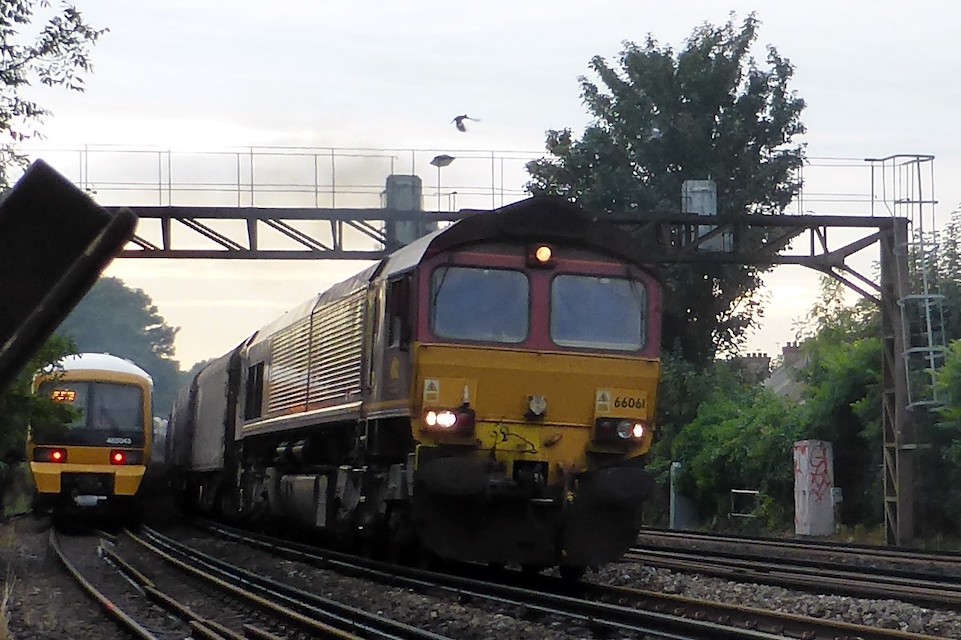Freight collaborates to improve Severn Estuary passenger service

Freight operators have collaborated to help make the most of improvements to the Severn Estuary line. The route, which crosses the border between South Wales and Gloucestershire in England, is the subject of a much-improved passenger timetable. That service has been slotted in around an already diverse roster of freight services.
Around forty freight train paths are diagrammed each day along the Severn Estuary. Now, there is an expanded passenger service, too. The line, which winds down the west bank of the river, was the subject of extensive civil engineering two years ago to stabilise steep earthworks.
Severn Estuary line is indispensable
The Severn Estuary line is the epitome of a network connection. No freight originates on its 25 miles (40 km). The modest settlement of Lydney is not a major passenger traffic generator, and Chepstow is only well known to the horse racing fraternity, who make the station exceptionally busy on race days. However, the line is a vital link for both freight and passenger traffic from England, Scotland and Wales.

For freight, the Severn Estuary line is indispensable. Even during the remedial engineering works of 2022, freight was accommodated on the line. Hardly an hour of the day goes by without a freight train pathed. A significant proportion of that traffic serves the British steel industry. “We broadly see loaded TATA steel trains running from Port Talbot and Llanwern [both Welsh steel plants] to Round Oak, Corby, Tees-side, Hull, Hartlepool, and empties returning”, said a Network Rail spokesman.
Round-the-clock nature of heavy industry
Transport for Wales, the government-owned operator, has introduced an intensive passenger service connecting Maesteg, Bridgend, Cardiff and Newport in Wales with Gloucester and Cheltenham in England. The service is part of a Welsh Government policy to enhance services. There’s, in line with a revamped fleet and other infrastructure work, including the long-term South Wales Metro programme. CrossCountry Trains, which operates throughout Great Britain, is also a frequently scheduled user of the line.

The round the clock freight operation may not be to the convenience of everyone in Lydney and Chepstow. However, the hours before the first passenger service, at around five-thirty in the morning, leave paths for plenty of freight operations. Even so, the round-the-clock nature of heavy industry in South Wales demands constant resupply. Some daytime hours have up to ten freight and passenger paths. It’s been a collaborative squeeze to fit into the expanded operation.
Deposit return scheme via the line
For freight, a more direct route between the South Wales and the West of England exists via the Severn Tunnel. However, there are restrictions on the type of train that can use the Severn Tunnel, quite apart from the intense passenger train schedule. That means that volatile commodities, such as fuel oil from Welsh port and refinery facilities, depend on the line. “Loaded fuel trains run Up this way to Westerleigh [storage facility near Bath] and return empty Down, said Network Rail, using the British direction convention.
Scrap metal trains from the North of England use the line to reach Celsa Steel near Cardiff. They take steel products the other way. If plans to replace the traditional coke-fired blast furnaces at Port Talbot go ahead, more scrap steel will be needed for the electric arc production facilities. One other commodity is transported via the Severn Estuary line. Supermarket chain Tesco sends container trains from Daventry Rail Freight Terminal in the English West Midlands. They’re loaded with supplies for the shelves of Welsh stores, to Wentloog in Cardiff. The empty containers return in rail freight’s own deposit return scheme.





